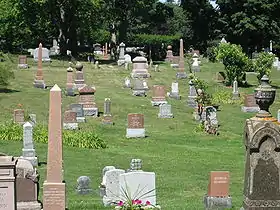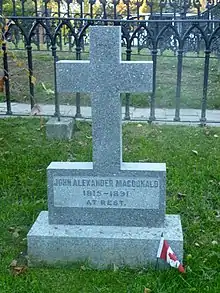Cataraqui Cemetery
Cataraqui Cemetery is a cemetery located in Kingston, Ontario, Canada. Founded in 1850, it predates Canadian Confederation, and continues as an active burial ground.[1] The cemetery is 91-acres in a rural setting with rolling wooded terrain, ponds and watercourses.[2] More than 46,000 individuals are interred within the grounds, and it is the final resting place of many prominent Canadians, including the burial site of Canada's first prime minister, Sir John A. Macdonald.[3] The Macdonald family gravesite, and the cemetery itself, are both designated as National Historic Sites of Canada.[4][5][6]
 Cataraqui Cemetery. | |
| Details | |
|---|---|
| Established | 1850 |
| Location | |
| Size | 91 acres (0.37 km2) |
| Website | www |
| Official name | Sir John A. Macdonald Gravesite National Historic Site of Canada |
| Designated | 1938 |
| Official name | Cataraqui Cemetery National Historic Site of Canada |
| Designated | 2011 |


History
The cemetery charter was created during a special act of the Legislative Assembly of the Province of Canada on August 10, 1850.[7] The Cataraqui Cemetery was incorporated as a not-for-profit, non-denominational, and public resting place.[8] Sir Alexander Campbell served as the first president.[7] Architect Frederick Cornell designed the cemetery landscape.[5] Interments increased quickly when the City of Kingston passed a by-law in 1864, preventing burials within the city limits.[8] The gravesite of Sir John A. Macdonald and family plot, were recognized as a National Historic Site of Canada on May 19, 1938.[6] Cataraqui Cemetery as a whole was recognized as a National Historic Site of Canada on July 19, 2011.[5]
Notable interments
Cataraqui Cemetery is the final resting place for many notable persons including; politicians, businessmen, humanitarians, and authors.[9] The cemetery contains the war graves of 61 service personnel from World War I, and 84 from World War II.[10] Queen's University owns a section that is reserved for interring the remains of those who dedicate their bodies to education and research.[11]
- Leonard Birchall – Royal Canadian Air Force officer[9]
- Thomas Burrowes – Artist and surveyor[9]
- John Counter – First mayor of the City of Kingston[9]
- Sir Alexander Campbell – Father of Confederation, and a former Lieutenant Governor of Ontario[12]
- Wallace Bruce Matthews Carruthers – Founder of the Canadian Signal Corps[9]
- Richard Cartwright – Judge and politician[9]
- James Alexander Corry – Academic and principal of Queen's University[11]
- William Coverdale – Architect[9]
- John Creighton – Politician and warden[9]
- John James Deutsch – Economist and principal of Queen's University[11]
- Harriet Dobbs – Artist, writer and humanitarian[9]
- George Monro Grant – Minister and principal of Queen's College[11]
- John Hamilton – Politician and cofounder of Queen's University
- George Airey Kirkpatrick – Politician and Lieutenant Governor of Ontario[9]
- Thomas Kirkpatrick – First mayor of the Town of Kingston
- William Leitch – Scientist and principal of Queen's University.[11]
- Evan MacColl – the poet of Loch Fyne
- John A. Macdonald – First Prime Minister of Canada[6]
- Archibald Cameron Macdonell – Police officer and soldier[9]
- Agnes Maule Machar – Author, poet and social reformer[9]
- John Machar – Principal of Queen's University[11]
- William Archibald Mackintosh – Economist and principal of Queen's University[11]
- Thomas McLeod – Scottish sailor who took part in three expeditions to the South Pole[9]
- James Morton – Politician, and businessman[9]
- Edward John Barker Pense – Politician, and newspaper editor[9]
- Guilford Bevil Reed – Canadian medical researcher[11]
- James Richardson – Businessman, founder of James Richardson and Sons, Limited[9]
- James Sampson – Doctor, politician and a founder of Kingston General Hospital[9]
- Charles Sangster – Poet, fellow of the Royal Society[9]
- David Chadwick Smith – Economist and principal of Queen's University[11]
- Henry Smith – Politician and lawyer[9]
- James T. Sutherland – Soldier, and Hockey Hall of Fame member[9]
- Robert Charles Wallace – Geologist, educator, academic administrator[11]
- Zachary Taylor Wood – Commissioner of the North-West Mounted Police, and Yukon Territory
References
- "Cataraqui Cemetery National Historic Site of Canada". Kingston Association of Museums. Retrieved 2018-01-25.
- "The Cataraqui Cemetery Historical Plaque". Ontario's Historic Plaques. Retrieved 2018-01-25.
- "Cataraqui Cemetery National Historic Site of Canada". The Great Waterway. Retrieved 2018-01-25.
- Gerard, Steve (2012-01-17). "Government of Canada Recognizes Historical Significance of Cataraqui Cemetery". Kingston Herald. Retrieved 2018-01-25.
- Cataraqui Cemetery National Historic Site of Canada. Directory of Federal Heritage Designations. Parks Canada. Retrieved 2018-01-25.
- Sir John A. Macdonald gravesite. Canadian Register of Historic Places. Retrieved 2018-01-25.
- "History of Cataraqui Cemetery". Cataraqui Cemetery. Retrieved 2018-01-25.
- "Kingston's Cemeteries". Kingston's Lower Burial Ground. Retrieved 2018-01-25.
- "Notable People". Cataraqui Cemetery. Retrieved 2018-01-25.
- "KINGSTON (CATARAQUI) CEMETERY". Commonwealth War Graves Commission. Retrieved 2018-01-25.
- "Cataraqui Cemetery". Queen's Encyclopedia. Retrieved 2018-01-25.
- "Sir Alexander Campbell". History & Innovation. Archived from the original on 2018-01-26. Retrieved 2018-01-25.
Further reading
- Jennifer McKendry, c1995 Weep not for me : A photographic essay and history of Cataraqui Cemetery Kingston, Ontario
- John H. Grenville, 2000 An illustrated guide to monuments, memorials & markers in the Kingston area Kingston Historical Society Plaque Committee, Kingston, Ontario, Kingston Historical Society
- Jennifer McKendry, c2003 Into the silent land : Historic cemeteries & graveyards in Ontario Kingston, Ontario
External links
![]() Media related to Cataraqui Cemetery at Wikimedia Commons
Media related to Cataraqui Cemetery at Wikimedia Commons